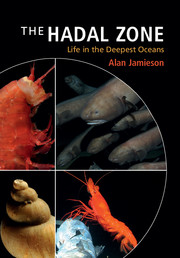Part II - Environmental conditions and physiological adaptations
Published online by Cambridge University Press: 05 February 2015
Summary
Introduction
The hadal trenches are geographically disjunct deep-sea ecosystems. Many have trench-specific geographical settings and thus often unique environmental conditions. Considering all trenches to be a single habitat, i.e. simply ‘hadal’, it is likely to confound interpretation of environmental drivers. Many environmental aspects are applicable to all hadal environments (e.g. increase in hydrostatic pressure with depth); however, there are those which only apply to a specific trench. Certain environmental conditions exhibit inter-trench variation, a result of the interactions between, for example, the local hydrography (temperature, salinity and oxygen), trench topography, seismic activity, substrata and hydrostatic pressure. Direct measurements of some of these parameters across multiple trenches are nonexistent, sparse, spurious or noncomparable. With the exception of topography and seismic activity, the hadal trenches experience similar conditions to the surrounding abyssal zone, for example, absence of light, low temperatures, salinity and oxygen.
Coping with, or rather adapting to, high hydrostatic pressure is perhaps one of the most important prerequisites to survival in the hadal zone. High-pressure (and low temperature) adaptations are common to all deep-sea organisms, but in the case of pressure, none more so than to those inhabiting the trenches. Furthermore, the process of ossification (the creation of hard shells) cannot occur beyond the carbonate compensation depth (CCD; >4000–5000 m) and this, in addition to other stresses, has prompted further adaptation enabling organisms to compensate for the high pressures with softer, more organic, physiological structures (e.g. Todo et al., 2005).
- Type
- Chapter
- Information
- The Hadal ZoneLife in the Deepest Oceans, pp. 73 - 74Publisher: Cambridge University PressPrint publication year: 2015

